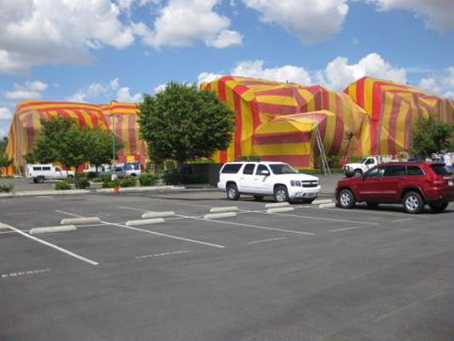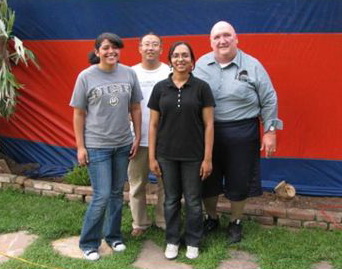
Fumigating a structure.

Field research assistants and Dr. Krieger (back row, far right)
of the Personal Chemical Exposure Program, UC Riverside.
Structural Fumigation
Structural fumigation is a pest control tool for eliminating damaging
pests that are difficult or impossible to control by other methods, including localized
insecticide application. Structural fumigations using sulfuryl fluoride have been
performed on residences, businesses and other structures for fifty years. Most residents
in California, Florida, Hawaii and other warm climate states are familiar with the brightly
colored tarps used to contain the fumigant within the structure to eliminate drywood termites,
wood-destroying beetles, or other pests including bed bugs.
The purpose of this webpage is to provide information about structural fumigation, sulfuryl
fluoride, and current research and initiatives related to fumigation. Information provided
here is a joint effort between
UC Riverside Personal
Chemical Exposure Program (PCEP) and UC Berkeley Urban Pest Management Center (UPMC).
Personal Chemical Exposure Program
The Personal Chemical Exposure Program in the Department of Entomology at the University
of California, Riverside, conducts human and environmental studies intended to clarify and define
important chemical exposure issues. Concepts in chemical exposure assessment related to their
research include risk assessment, mitigation, perception and regulation.
UC Riverside's recent research evaluating
fumigation of residences using sulfuryl fluoride
Frequently Asked Questions About Structural Fumigation
Personal Chemical Exposure Program staff periodically respond to questions from the public about
fumigation. Some common questions and answers are included here. Fumigation technology is
well-studied and answers to questions about specific work practices and safe fumigant use may be
obtained from the trained professionals who work as sulfuryl fluoride fumigators, pesticide
registrants, and state regulators.
Why are buildings fumigated with sulfuryl fluoride?
Sulfuryl fluoride is the most important structural fumigant in the United States for the treatment and
control of structure-infesting pests. Scientists have shown that fumigation is a reliable and complete method
for elimination of infestations of drywood termites and other pests such as wood-destroying beetles and
bed bugs, in buildings.
How many fumigations with sulfuryl fluoride are conducted each year in California?
About 100,000 fumigations with sulfuryl fluoride are conducted each year in California. Costs for control and
repair of damage from drywood termites in California exceeds $300 million annually and are projected to increase.
What sulfuryl fluoride products are registered for structural fumigation of residences and other buildings in California?
There are three sulfuryl fluoride products registered for structural fumigation of residences and other buildings in California.
| Registrant |
Brand Name |
U.S. EPA Reg. No. |
| Dow AgroSciences LLC |
Vikane |
62719-4-ZA |
| Ensystex II, Inc. |
Zythor |
81824-1-AA |
| Drexel Chemical Company |
Master Fume |
19713-596-AA |
What procedures do fumigators follow to protect the safety of neighbors
and building occupants during fumigation with sulfuryl fluoride?
There are many procedures that minimize the potential exposure of fumigators and other people to sulfuryl
fluoride during structural fumigation. Some of these are illustrated below with photos the PCEP researchers
captured during monitored fumigations.
The warning agent, chloropicrin, is introduced into the building per label directions prior to the introduction
of the fumigant sulfuryl fluoride. Chloropicrin serves to warn of the presence of the odorless and colorless
sulfuryl fluoride and is a deterrent to intruders. Chloropicrin is ventilated from the building with the
sulfuryl fluoride during aeration (Photo A).
All exterior entrances and sides of the fumigated building are posted with warning signs during the fumigation
process. In addition to stating the name of the fumigant used and warning against entry, the signs contain
24-hour contact information for the fumigation company (Photo B).
All exterior entrances are barricaded or locked with special locking devices. This procedure prevents residents
from using their keys to re-enter during the fumigation process (Photo C).
Fumigators must wear respiratory protection (SCBA-Self Contained Breathing Apparatus) if they enter the fumigated
space before it is aerated. NOTE: The new California Aeration Plan was developed so fumigators would not need to
enter the fumigated space to initiate aeration (Photo D).
Fumigators must follow detailed, validated procedures during the California Aeration Plan (CAP). These procedures
specify the type of ventilation equipment used, such as ducting and fans with required capacity to move air, and
the duration of ventilation period using fans (Photo E).
After completion of aeration, the fumigator must test the air in each room using the Interscan or SF-ExplorIR to
confirm aeration of the fumigant before allowing reoccupancy of the building (Photo F).
Toxic Air Contaminant: As defined by California Health and Safety Code, Section 39655 (a): an air pollutant which
may cause or contribute to an increase in mortality or in serious illness, or which may pose a present or
potential hazard to human health. Substances which have been identified by the U.S. EPA as hazardous air
pollutants (e.g. benzene, asbestos) shall be identified by the Board as toxic air contaminants.
Of course, an air contaminant is toxic only if air concentrations are high enough to cause adverse effects
(toxicity) in persons who are exposed.
Will fumigation with sulfuryl fluoride adversely affect water and soil?
Research and the chemical properties of sulfuryl fluoride demonstrate that this fumigant will not adversely
affect water or soil when used according to the label directions.
Sulfuryl fluoride has very low solubility in water (e.g. compared to sugar, salt or other soluble chemicals).
This beneficial feature of the product is why the product label recommends watering the perimeter of the
foundation prior to tarped fumigations. Water acts as a barrier to minimize movement of sulfuryl fluoride into
the soil between tarps and the building, improving confinement of fumigant during the fumigation.
Sulfuryl fluoride and chloropicrin are listed as a California Toxic Air Contaminant (TAC). Does this affect their use as a fumigant and warning agent, respectively, in homes and other buildings?
No, listing of sulfuryl fluoride and chloropicrin as TACs does not affect their label use directions. The regulatory standards for air levels have been reduced based upon scientific review of data from structural fumigation during application and aeration.
The TAC listing process is an additional step required by State law in California to identify materials that may be found in air. It is in addition to the actual risk characterization analysis done by California Department of Pesticide Regulation (DPR) and includes a separate review. Some other common chemicals listed as TACs include chlorine, formaldehyde, methanol, naphthalene, and toluene.
Will occupants returning to buildings following fumigation with sulfuryl fluoride be exposed to toxic
concentrations of the fumigant by off-gassing?
No. Due to the physical properties of sulfuryl fluoride, this fumigant does not accumulate inside a building following label-directed fumigation and aeration procedures. For fumigation the release of sulfuryl fluoride into the indoor air creates the natural force that drives sulfuryl fluoride gas into the depths of wood where drywood termites thrive. The driving force during fumigation is a concentration gradient---sulfuryl fluoride moves from the indoor air through the wood and other materials to the microscopic air spaces where no fumigant gas previously existed. The process is very rapid. During aeration the process is reversed when the fumigant concentration is rapidly reduced in the indoor air.
The higher concentrations within wood and other materials is rapidly reduced as sulfuryl fluoride comes out of the air spaces in the wood, the structure, and its contents during the aeration process after the fumigation seals to outside air are opened.
Toxic concentrations of sulfuryl fluoride are maintained indoors during fumigation by
tarping to seal fumigant inside the structure. The fumigant penetrates materials readily and it is very important
that the process works both ways (fumigant going in and coming out)! When aeration begins and the structure is ventilated,
the off-gassing also occurs very rapidly. Following the California Aeration Plan, the residence is tested using sensitive
detection equipment to confirm fumigant concentrations are 1 ppm or less, and is ready for reoccupancy.
The driving force continues to be low air levels going to still lower ones down a concentration gradient.
If buildings and materials retained sulfuryl fluoride, then fumigators would not need to use elaborate procedures,
including tarpaulins, polyethylene sheeting, and tape, to seal structures to keep sulfuryl fluoride inside
during the fumigation. Sulfuryl fluoride concentrations continue to decline to non-detectable levels
following aeration even without the aid of circulation fans and with closed windows and exterior doors.





